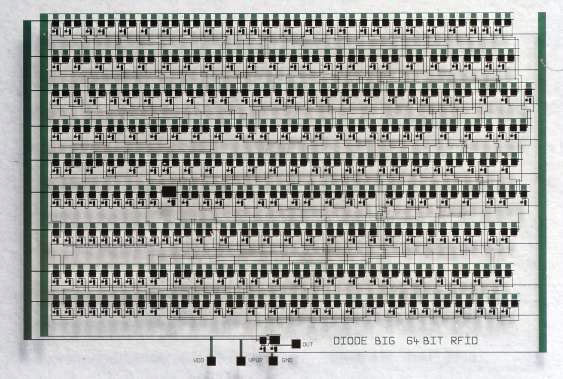|
|
| IMEC Reports Record Organic RFID Circuit |
 |
Text Size: A A A |
|
Researchers reported an organic TFT-based RFID circuit, with a record data rate and 10 V operation. The team, including researchers from IMEC, TNO and Polymer Vision, said the 64-bit transponder circuit has a data rate of 4.3 Kb/sec, twice as fast as the test circuit reported at last year's ISSCC. The team used a dual-gate design, with the top gate controlling the threshold voltage in the all-p-type technology.
David Lammers, News Editor -- Semiconductor International, 2/17/2010
A team of researchers drawn from IMEC (Leuven, Belgium), TNO Science and Industry (Eindhoven, Netherlands) and Polymer Vision (Eindhoven) described a dual-gate organic RFID design at the International Solid State Circuit Conference (ISSCC), held earlier this month in San Francisco.
The team adapted an all-p-type (unipolar) dual-gate technology from flexible display company Polymer Vision. The top gate in the dual-gate architecture is used to control the threshold voltage (Vt), leading to a multiple-Vt technology that supports faster circuits at lower operating voltages.
The team started out with the organic transistors used by Polymer Vision in its flexible displays. The transistors use an organic insulator layer and a p-type pentacene semiconducting layer, processed from solution. The transistors have a typical channel length of 5 μm and an average saturation mobility of 0.15 cm2/Vsec.
The 64-bit transponder circuit presented at the 2010 ISSCC has a data rate of 4.3 Kb/sec, twice as fast as the circuit presented by the same group at last year's ISSCC; and operates as low as 10 V, suitable for capacitive and inductive coupling with an RFID readout station.

The 64-bit RFID chip was made with a dual-gate, organic TFT technology. (Source: IMEC)
N-type transistors are difficult to create in organic materials, limiting CMOS operation and forcing most circuit designers thus far to use a single-Vt, p-type device with "intrinsic limitations concerning integration of larger circuits," said IMEC researcher Kris Myny. Rather than attempt an organic complementary technology, the team used a depletion-type dual-gate technology in which the top gate is coupled more weakly to the channel than the bottom gate. The top gate is used as the Vt control gate.
Previous attempts to use dual-gate organic TFTs have been limited to simple inverters. The IMEC-Holst-TNO team developed more complex circuits, including a 99-stage dual-gate ring oscillator and the RFID transponder.
The voltage of the top-gate drive transistor is relatively high, 30-45 V, which the team said requires the use of charge pumps and limited currents. The researchers said they operated the chips with a 1 nA current, in compliance with the voltage supply of the top gate of the driver transistor.
The collaboration was supported by the Holst Centre (Eindhoven).
|
|











